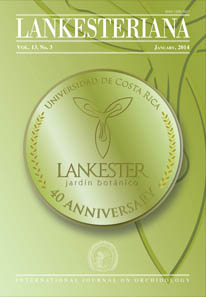Charles H. Lankester (1879-1969): his life and legacy
DOI:
https://doi.org/10.15517/lank.v13i3.14424Abstract
Charles Herbert Lankester (1879-1969) was without a doubt the most dominant figure of Central American orchidology during his time. Better known as ‘Don Carlos’, Lankester was born in Southampton, England, on June 14 1879. It was in London that he read an announcement offering a position to work as an assistant to the recently founded Sarapiquí Coffee Estates Company in Costa Rica, he applied and was hired. Surely influenced by his uncle’s zoological background, Lankester was at first interested in birds and butterflies. However, living in Cachí, at that time one of the regions with the greatest botanical diversity, he must have fallen under the spell of the plant world as he soon began collecting orchids in the nearby woods. Many of the plants he collected at this time proved to be new species. With no literature at his hand to determine the plants he collected, Lankester started corresponding with the assistant director of the Royal Botanic Gardens at Kew, Arthur Hill in 1910, and somewhat later with Robert Allen Rolfe, Kew’s most eminent authority on orchids. At the same time, Lankester began his collection of living plants that would become so famous years later. He returned to England in 1920 to enroll his five children in English schools. Lankester traveled to Africa from 1920 to 1922, hired by the British Government to do research on coffee plantations in Uganda. When returning to England, he found that Rolfe had died the year before. Many orchids that he had brought to Kew were left without identification. Lankester was back in Costa Rica in 1922, the year that was a turning point in his career as an orchidologist: it brought the first correspondence with Oakes Ames. Over the next fifteen years, Ames would discover more than 100 new species among the specimens he received from Costa Rica. In 1922, Ames began a series of publications on orchids, which he named Schedulae Orchidianae. In its third fascicle, in January 1923, Ames started to describe many of the Lankester orchids, which were deposited at Kew and had been left unidentified. Ames kept asking Lankester to send more and more specimens. After 1930, Lankester and Ames seem to drift slowly apart. Ames was taken in more by administrative work at Harvard, and Lankester traveled abroad more frequently. In 1955, after his wife’s death and already 76 years old, Lankester decided to sell his farm but retained the small part which contained his garden, a piece of land called “El Silvestre”. Lankester moved to a house he had bought in Moravia, one of the suburbs of the capital, San José. On a section of this farm called “El Silvestre”, Lankester began his wonderful collections of orchids and plants of other families, which formed the basis of the Charles H. Lankester Botanical Garden of the University of Costa Rica.Downloads
Download data is not yet available.
Downloads
How to Cite
Ossenbach, C. (2014). Charles H. Lankester (1879-1969): his life and legacy. Lankesteriana: International Journal on Orchidology, 13(3). https://doi.org/10.15517/lank.v13i3.14424
Issue
Section
Introductory paper
License
According to the Open Access policy promoted by the University of Costa Rica, all the papers published by Lankesteriana are licensed under the Creative Commons copyright and can be downloaded free of charge. The journal holds copyright and publishing rights under the CC BY-NC-ND 3.0 CR license.
Before the publication of the materials submitted by the author(s) in LANKESTERIANA, the author(s) hereby assign all rights in the article to the Lankester Botanical Garden.








